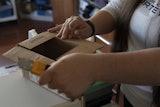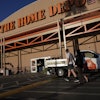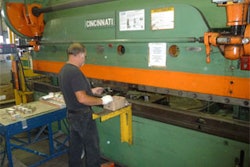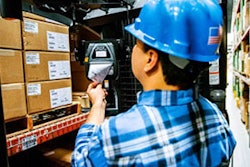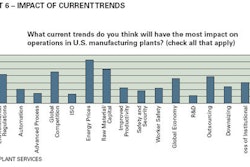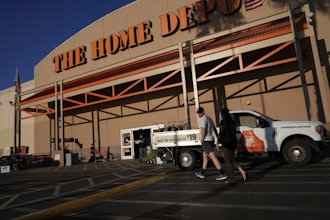This article first appeared in IMPO's May 2013 issue.
There is no such thing as a vibration free machine,” says Steve Matthews, business manager of VibrAlign’s service company, PdM Solutions, Inc. Rotor unbalance, sheave misalignment, worn bearings, loose bolts, and bearing lubrication issues can affect every machine on the plant floor. And when they do, costly and dangerous failures can result. Monitoring critical rotating machinery can help mitigate the risk, allowing maintenance technicians to avoid unnecessary and unscheduled downtime by getting in front of an issue before it becomes a problem.
Reliable Vibration Detection
A good vibration analysis program starts with an experienced and skilled vibration analyst. “Without this, all other considerations are not worth discussing,” says Matthews. “The best tool is a good analyst.”
A good analyst means a technician who is well versed in vibration monitoring: someone who is able to recognize fault patterns of machinery. “What is really important for predictive programs to be successful is to know when the levels have gone high enough to warrant a maintenance action,” adds Matthews. The skill to determine “the precise nature of detected vibration, the appropriate corrective action, and when to take that action (severity) can take several years to develop.” Taking action too soon due to the early detection of a bearing fault could lead to unnecessarily replacing a part that could have lasted for years more. Taking action too late could lead to a costly and unexpected machine shutdown.
This expertise can be garnered via training, hiring a worker with vibration detection expertise, or partnering with a qualified contractor who can provide this service. Service providers today have solved the problem of having the most qualified analyst always available — including during vacations, job changes, sick days, shift changes, and unexpected leaves of absence. They are able to “achieve consistency and focus on the importance of the program to profitability, and create a zero tolerance culture for unplanned downtime,” explains Randy Johnson, vice president of sales, marketing, and operation with Azima DLI — a provider of predictive maintenance analytical services and products.
“Unless there are experienced in-house personnel on staff, this job should be left to the professional,” stresses Jeffrey P. McGuckin, president of Vibration Specialty Corporation.
If personnel are all too busy to fill the role of vibration detector or analyzer and a company turns to a service provider, “it is critical to actually do the math and calculate the cost of this additional person unless they will be used to fill other needs around the plant,” McGuckin says. “Devoting one person to the vibration program full time quickly drives up the costs of the program.”
Cost Of Analysis
Facility managers must remember there is a cost to a vibration monitoring program. “It is critical that the cost of the program is not greater than the costs to run the machinery to failure,” explains McGuckin. “Even if the cost to monitor is greater than the cost of failure, you may still be able to justify some monitoring for the peace of mind it brings knowing the condition of your equipment.” But he adds that, “in most cases, the numbers will show that monitoring is warranted.”
In the long run, it is most cost effective to do as much of the work as possible in-house, but contractors can be the economical choice when developing in-house expertise is not an option.
Also factoring into the vibration monitoring cost equation is the cost of failure for each critical machine or machines facility managers wish to monitor, says McGuckin, which includes the cost of repairs (parts, man power, and production losses). “Facility managers know how much money per hour their plant makes, which can be used as a cost of failure on any machine that causes the plant or production line to stop production,” he explains. “They must estimate the time for the repair, which maintenance personnel should be able to provide, and then come to a per machine cost of failure.” This number can then be compared to the cost to monitor the machine. One way to get the cost to monitor is to have a qualified contractor provide an estimate to conduct a vibration survey on the machinery. “If they provide a total number for all the machines, you can divide the estimate by the total number of machines to get a quick per machine cost,” McGuckin says. “This calculation will tell you whether a program makes financial sense.”
Assuming a facility can justify the numbers, a facility manager must then understand what a vibration analysis program entails beyond an analyst and the cost: the tools.
LUDECA Inc.’s Trent Phillips, condition monitoring manager, discusses how facility managers can best determine vibration monitoring intervals for critical machinery: First, the point in time (P) that the potential failure becomes detectible must be known (detected with vibration monitoring, etc.). Second, the time (F) at which the potential failure would degrade to a functional failure must be known. This difference in time (P-F Interval) is the window to take corrective action and avoid the negative consequences of the failure. This difference in time will determine how often conditional tasks such as vibration monitoring must be done to detect potential failures such as bearing issues. Typically, the monitoring interval would be set to half of the P-F interval. This allows enough time for the technology to detect the problem and corrective action to be taken. However, in certain circumstances it may be necessary to collect data at shorter intervals than half of the P-F interval. For information on selecting the right condition monitoring technology for your facility, go to |
The Right Tools
“The tool must have the correct analytical capabilities, be upgradeable, promote standards, have very good data reporting capabilities, integrate into plant systems, provide root cause analysis capabilities, and be easy to use,” says LUDECA Inc.’s Trent Phillips, condition monitoring manager. “Not all vibration analysis devices are created equal.”
An analyzer with poor capabilities that cannot collect data in all directions, or a program set up by an unqualified technician are two easy ways to gather poor data. And poor data will make reliable analysis difficult, at best.
“One aspect of gathering quality data is ensuring you are collecting all of the data from all directions on every bearing,” McGuckin explains. Tri-axial (horizontal, vertical, and axial) vibration readings commonly show vibration levels increasing in only one direction, which would have been missed if the user did not collect data in that particular direction, resulting in eventual machine failure. “You can certainly play this game of Russian roulette, but know your risks so you do not experience a failure and lose the program,” he adds.
A single channel analyzer, or a four channel analyzer equipped with a single axis probe, can take three times longer to collect the same data as a tri-axial instrument, costing time and money. It can also create what some technicians may perceive as an easy shortcut, and they could skip collecting data in the vertical and axial directions. A three to four channel vibration instrument with a tri-axial accelerometer automatically captures all three directions simultaneously.
“And many personnel are forced to skip axial readings near couplings and sheave even if they want to read them,” adds McGuckin, “because of the safety risks of the sensor, cabling, or their hand getting caught in the rotating element.” A permanent sensor connected to an online monitoring system that constantly monitors vibration may also be a worthy investment, so personnel no longer need to conduct the data collection at these dangerous points. “You must be able to justify the higher initial monitoring cost, but a high value on safety could make such an investment worthwhile.”
While a quality three or more channel system with a tri-axial sensor should be able to be purchased for under $25,000, says McGuckin, he also advises, “The time you save in collecting data will quickly pay for the cost of these items.”
An alternative to purchasing these instruments is renting, which can provide a “viable alternative to make them available and part of your reliability efforts,” adds Phillips. “It can be difficult to justify purchasing these tools when they are not needed routinely and renting them as needed may be more cost effective.”
Catch Impending Failure
Keeping a vibration monitoring program cost effective also means monitoring critical machines at a frequency high enough to catch impending failures, but not too often that time spent monitoring vibration is wasted. And older machines don’t necessarily require more monitoring than newer machines, says Phillips: “Most equipment failures are not age related and the equipment will provide some sign of impending failure.”
“It is important not to assign monitoring intervals based upon gut feelings or calendar intervals,” he stresses.
A facility’s vibration monitoring frequency “depends on the facility,” says Matthews, but deciding factors include:
- How critical is the machine to the process?
- Does the machine pose a safety hazard (personnel or environmental) if it fails?
- What is the expense for repair of the machine if it fails?
- What are the operation conditions of the machine (light duty versus extreme duty)?
“You just don’t want a failure to develop between surveys,” Matthews explains. For highly critical systems that involve high downtime production costs, he adds that online monitoring is often implemented to collect data every day, or even many times per hour.
“The most important part is that you want to collect at least three surveys of data prior to a failure so you can see how the machine is trending and take action,” adds McGuckin. “If a machine can fail within four months, then you will need to monitor at least monthly to be able to detect the rising trend.”
A machine’s maintenance history can also be used to help determine a preliminary monitoring interval, and the amount of time it takes the machine to move from “normal” operation to “catastrophic failure mode.” Without this data, technicians often begin checking vibration levels monthly or quarterly to establish a machine trend. “Once the levels stabilize for approximately three months, you can consider extending the monitoring interval until data indicates a change where closer monitoring is warranted,” McGuckin says. “Anytime a machine shows a change in vibration, you should seriously consider increasing its monitoring interval so you know if action is necessary in the near future.” Exceptions to this rule are when the machine has a low cost of failure (which can warrant extended monitoring intervals) or when new parts are repaired or installed (which can warrant a period of more frequent monitoring).
All of these components go toward a more reliable, predictable, and — possibly most importantly — safer plant floor. And says Phillips, “A plant that is not reliable cannot be safe.”
